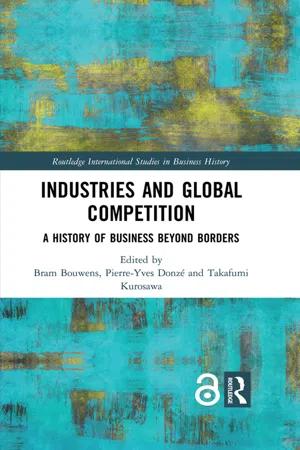Introduction
The tobacco industry is composed of many firms manufacturing a variety of tobacco products, such as cigars, pipe tobacco, chewing tobacco, snuff, and cigarettes. Among these, machine-made cigarettes are a special case of standardized products, and cigarette factories have become gigantic to gain economies of scale (Proctor 2012). After the emergence of machine-made cigarettes in the late 19th century, cigarette manufacturers succeeded in penetrating new markets and homogenizing their products through mass production and mass advertising around the world. As a result, cigarette consumption surpassed all other forms of tobacco consumption successively in the United Kingdom 1920, Japan 1923, Austria 1939, the United States 1941, and France 1943 (Goodman 1993; Japan Tobacco 1963). Today, about six trillion cigarettes are consumed worldwide, representing a 3% increase from the 2000s. China, the largest market, and the Eastern Mediterranean region are playing especially large roles in the growth of cigarette consumption despite reduction in smoking rates brought about by the passage of tobacco control laws that restrain the sale and advertising of tobacco and forbid smoking in public in other countries (The Tobacco Atlas n.d.).
Traditionally, the tobacco industry has developed either in the private sector or as a government monopoly. In the former case, since the late 19th century, mergers and acquisitions (M&As) were used as a major means to expand market share, particularly in the United States and the United Kingdom. In the United States, the American Tobacco Company (ATC) was established in 1890 by amalgamating five cigarette manufacturers. The ATC then entered Canadian, Australian, Japanese, and German markets through foreign direct investments (FDI) in the late 1890s (Cox 2000). In 1901, the ATC acquired the British company Ogden & Co. Ltd. and started conducting business in the United Kingdom. In reaction, the first mover in British tobacco industry, W.D. & H.O. Wills, merged 16 companies to form the Imperial Tobacco Co. (ITC) (Chandler 1990). Fierce competition between the ATC and the ITC led to an agreement between them and the creation of a new company in London in 1902 called the British American Tobacco (BAT). ATC owned two-thirds of the capital of BAT, and ITC held one-third. The aim of BAT was to engage in the tobacco business in the world outside the United States and the United Kingdom. Therefore, BAT was born as a multinational enterprise (MNE) from the beginning (Alford 1973; Cox 2000). Yet, due to an antitrust case in the United States, the ATC was dissolved in 1911. Its shares in BAT were acquired by British investors, and it became ‘the overseas arm of Imperial’ (Chandler 1990, p. 247). In the United States, the ATC was broken up by the Federal Trade Commission into four companies (American Tobacco, R. J. Reynolds, Ligget & Myers, and Lorillard). Together with Philip Morris, a company founded in 1902, which succeeded in building a strong cigarette brand, Marlboro, these companies dominated the US market and became major players in the tobacco business throughout the world during the 20th century (Brandt 2007).
The next dramatic change in this industry occurred in the 1990s. The privatization of state-owned tobacco companies in many countries around the world provided the opportunity for a few MNEs, mostly American and British, to expand geographically in the context of an international cigarette market that had reached maturity. Gilmore, Fooks, and McKee (2011) stated that 30 countries privatized their tobacco business during the 1990s, followed by seven other countries in 2000–2008. Nearly all these former state-owned firms were acquired by the top four MNEs, namely Philip Morris International (PMI), British American Tobacco (BAT), and its associates, Japan Tobacco (JT) and Imperial Tobacco (IT). According to Physicians for a Smoke-Free Canada (2009), increased corporate concentration brought nearly 50% of the world’s cigarette market under the control of these four MNEs (PMI, 16%; BAT, 16%; JT, 11%; and IT, 6%).1 Thus, the global cigarette market is increasingly concentrated in the hands of a very few MNEs.
This chapter focuses on JT, drawing comparisons with two other giants, PMI and BAT. In contrast with these two Western MNEs, JT offers the rare case of a former state-owned enterprise that succeeded in transforming itself into an MNE after the privatization of 1985.2 Consequently, this chapter intends to clarify how JT, whose overseas business had been the scanty export of its cigarettes to Southeast Asian countries until 1985, was able to become a top MNE in the cigarette industry. The main research question addressed in this study is as follows: How was JT able to build the necessary capabilities and adopt a proper global expansion strategy in a highly competitive market dominated by few British and American MNEs?
This chapter has two main purposes. One is to examine what competitive advantages JT has in the global cigarette market using a comparative analysis of the leading firms’ three-pronged investments (production, distribution, and organizational capabilities) as defined by Chandler (1990). The other objective is to clarify how JT achieved its competitive advantages by exploring its history. Therefore, this chapter focuses on firm-level competitiveness in order to clarify how JT succeeded in expanding its business beyond Japan’s borders to become one of the big three manufacturers despite its late entry into the global cigarette market.
The literature on international business and global management offers a broad range of theories and concepts that could be used to analyze JT’s specific characteristics and sources of competitive advantage. This chapter builds in particular on the eclectic paradigm developed by Dunning (1979, 1995, 2000) to understand JT’s ownership-specific and/or location-specific advantages that motivated its internationalization. According to Dunning, ownership-specific advantages of firms of one nationality over those of another include a benefit of some sort while operating and competing in unfamiliar foreign markets. For instance, intangible assets, access to the capacity of a parent company at favored prices, and economies of joint supply can be regarded as ow...
